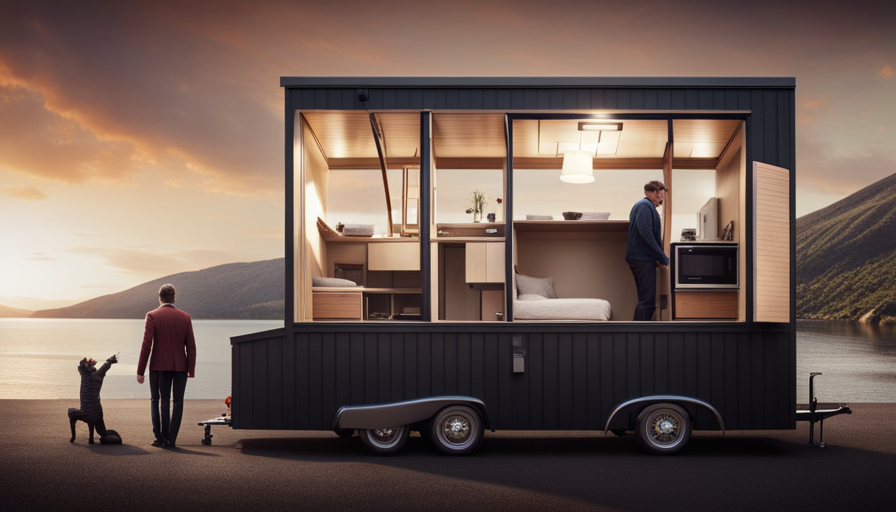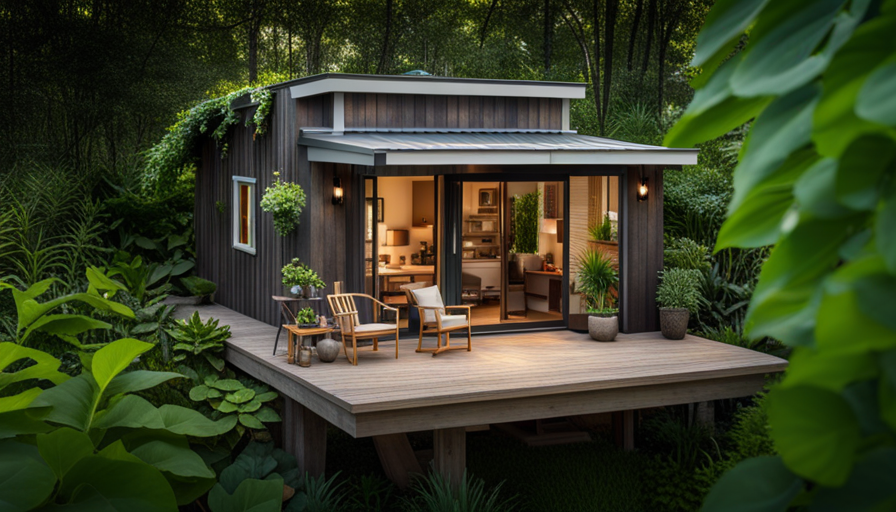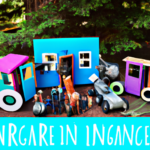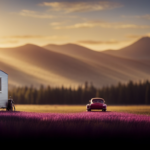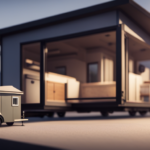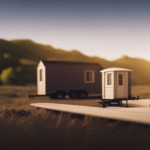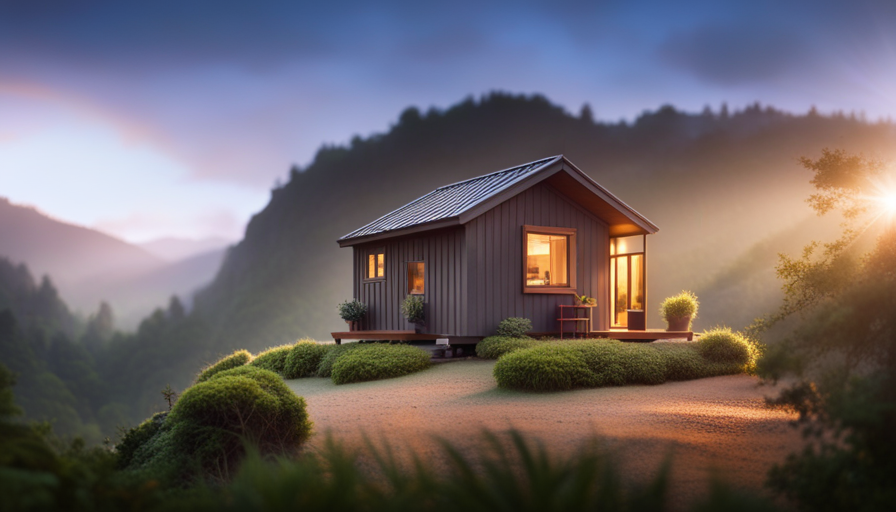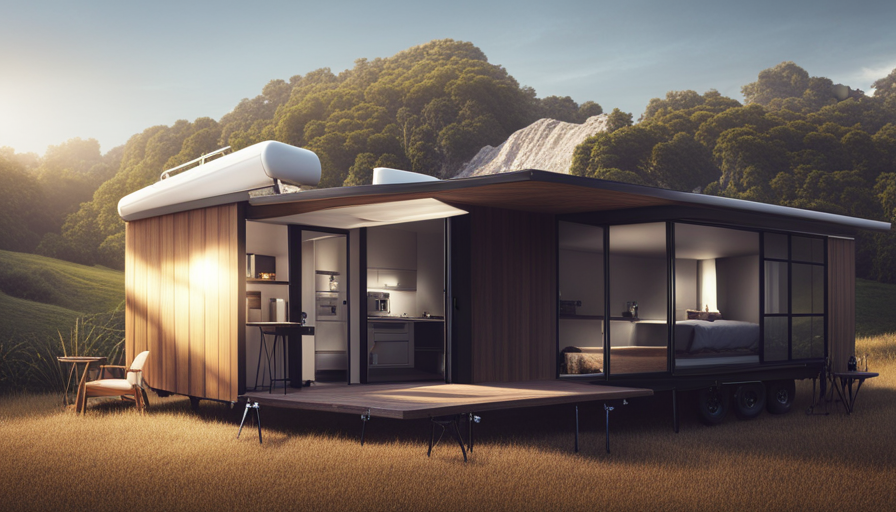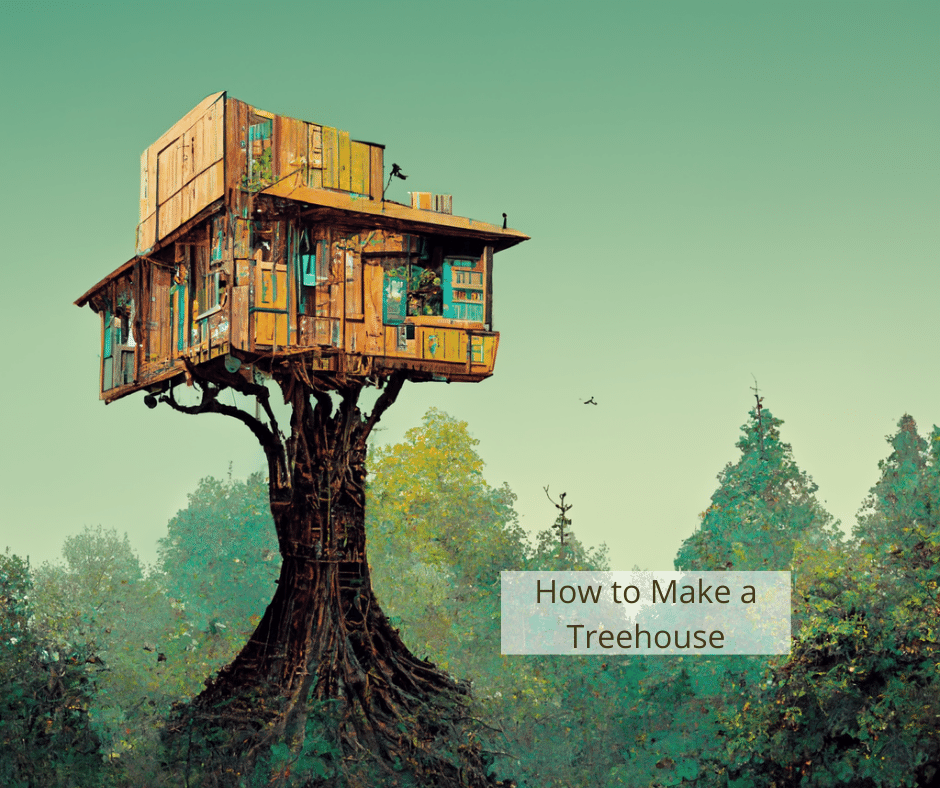Have you ever dreamed of simplifying your life and living in a cozy, compact space? Get ready for an experience that will turn this dream into reality.
Welcome to the world of tiny houses on trailers, where you can build a home that’s both small in size and big on charm. But before you start hammering away, it’s important to understand the legal limitations and building codes that come into play.
From there, you’ll need to consider practical considerations like trailer size and efficient floor plans. Ensuring safety and stability is crucial, as is budgeting for construction costs. And of course, you’ll have to decide whether to hire professionals or tackle the project yourself.
Once you’ve covered all the bases, you can customize your tiny house to fit your needs and enjoy the countless benefits of living in a tiny, yet mighty, space.
So, let’s dive in and explore just how big of a tiny house you can build on a trailer.
Key Takeaways
- Legal limitations and building codes must be considered before building a tiny house on a trailer.
- Practical considerations like weight restrictions and towing capabilities are important when determining the size of a tiny house on a trailer.
- Lifestyle and space needs should be assessed when designing a tiny house on a trailer.
- Efficient floor plans, multi-purpose layouts, and maximizing natural light are important considerations for maximizing space and functionality in a tiny house on a trailer.
Understanding Legal Limitations and Building Codes
So, how big of a tiny house can you actually build on a trailer while still abiding by all the legal limitations and pesky building codes?
When it comes to building a tiny house on a trailer, there are certain building code requirements and legal restrictions that you need to be aware of. These regulations vary depending on your location, so it’s essential to research and understand the specific rules in your area.
Building code requirements typically dictate the minimum square footage, ceiling height, and safety standards for a dwelling. These codes aim to ensure that the structure is safe and habitable. Additionally, there may be restrictions on the maximum height, length, and width of the tiny house, as well as limitations on plumbing and electrical systems.
To comply with these regulations, it’s crucial to consult with local authorities or a building professional who specializes in tiny homes. They can guide you through the process, help you understand the legal limitations, and ensure that your tiny house meets all the necessary requirements.
Considering practical considerations, such as weight restrictions and towing capabilities, is also important when determining the size of your tiny house on a trailer. By taking into account both the legal and practical aspects, you can find the right balance and design a tiny house that meets your needs and complies with all necessary regulations.
Considering Practical Considerations
When considering practical considerations for building a tiny house on a trailer, it’s important to assess your lifestyle and space needs. This involves determining the number of people who’ll be living in the tiny house and what activities will be taking place inside.
Additionally, planning for essential amenities and storage is crucial to ensure that you have everything you need in your limited space. Lastly, it’s vital to determine the weight capacity of the trailer to ensure that your tiny house is built within safe limits and can be easily transported.
Assess Your Lifestyle and Space Needs
Imagine, as you envision your lifestyle and space needs, the perfect tiny house on a trailer that symbolizes your freedom and minimalistic approach to life. Space optimization is crucial when designing a tiny house. Consider how many rooms you need and prioritize them accordingly.
Assess your lifestyle to determine if you require a dedicated workspace, entertainment area, or storage solutions. To further optimize space, think about incorporating multi-functional furniture such as beds with built-in storage or foldable tables.
Additionally, consider the size of your belongings and whether you’re willing to downsize to fit within the limited space. Lifestyle assessment is key to ensure your tiny house meets your unique needs and preferences.
Plan for essential amenities and storage to accommodate your daily activities and belongings.
Plan for Essential Amenities and Storage
Ensure that you carefully consider the essential amenities and storage options that will perfectly suit your lifestyle and needs when planning your ideal tiny home. In order to make the most of the limited space, it is crucial to focus on storage solutions and space optimization. Utilizing clever storage solutions like built-in cabinets, multipurpose furniture, and vertical storage will help maximize every inch of your tiny house. Additionally, incorporating space-saving techniques such as foldable tables and beds, as well as utilizing under-bed and wall-mounted storage, can further enhance the functionality of your small space. To evoke an emotional response and provide a visual representation, consider a 2 column and 3 row table showcasing various storage options and their benefits. By carefully planning for essential amenities and storage, you can create a comfortable and functional tiny home that meets your needs and lifestyle. Transitioning into the next section, it is important to also determine the weight capacity of the trailer.
Determine the Weight Capacity of the Trailer
To make sure your dream home on wheels can safely support all of your belongings, it’s essential to determine the weight capacity of the trailer. The weight capacity of the trailer is crucial in ensuring that it can handle the load of your tiny house without compromising its structural integrity.
To properly determine the weight capacity, you need to consider factors such as trailer weight distribution and trailer axle placement. These factors play a significant role in maintaining balance and stability while towing your tiny house. A well-balanced weight distribution ensures that the trailer remains level and reduces the risk of swaying or fishtailing during transportation.
Additionally, proper axle placement helps distribute the weight evenly, preventing excessive stress on specific areas of the trailer. By understanding these considerations, you can choose the right trailer size that can accommodate your tiny house without compromising safety and stability.
Choosing the Right Trailer Size
If you want to maximize space and mobility, you can’t go wrong with a trailer that’s big enough to fit all your essentials, like a cozy nest for a free-spirited bird. When choosing the right trailer size for your tiny house, it is crucial to consider the trailer weight and towing capacity. You need to ensure that the trailer can handle the weight of your tiny house while being towed safely.
To help you visualize the importance of trailer size, let’s take a look at the following table:
| Trailer Size | Dimensions (feet) | Maximum Tiny House Length (feet) |
|---|---|---|
| Small | 16-20 | 18 |
| Medium | 20-24 | 22 |
| Large | 24-30 | 28 |
As you can see from the table, choosing the right trailer size depends on the dimensions and weight of your tiny house. A small trailer may be suitable for a compact design, while a larger trailer provides more space for a comfortable living area. Consider your needs and the towing capacity of your vehicle when making this decision.
By selecting the appropriate trailer size, you lay the foundation for designing efficient floor plans that make the most of your available space. This transition sets the stage for the subsequent section on designing efficient floor plans.
Designing Efficient Floor Plans
Creating a well-designed floor plan is essential for maximizing the space and functionality of your compact living abode. When it comes to tiny houses on trailers, efficient space utilization is key. Here are two important considerations to keep in mind:
-
Multi-purpose Layout: To make the most of the limited square footage, it’s crucial to design a floor plan that serves multiple purposes. Think about incorporating features like convertible furniture, foldable tables, and hidden storage compartments. By optimizing every nook and cranny, you can create a space that feels larger than it actually is.
-
Maximizing Natural Light: Natural light is a valuable resource in any home, and it becomes even more important in a tiny house. Including large windows, skylights, and glass doors can help bring in abundant sunlight, making the space feel more open and airy. Additionally, using light-colored materials for walls and furniture can help reflect and distribute the natural light throughout the interior.
By carefully considering these factors, you can design a floor plan that efficiently utilizes the available space while maximizing natural light. This will create a comfortable and inviting living environment within your tiny house on wheels. Ensuring safety and stability is the next crucial step in the construction process.
Ensuring Safety and Stability
Once you’ve finalized the floor plan, it’s important to prioritize safety and stability. This includes ensuring your foundation is as sturdy as a rock and your structure is as solid as a fortress. Safety precautions should be taken into consideration throughout the entire construction process to ensure the structural integrity of your tiny house on a trailer.
When building a tiny house on a trailer, it’s essential to follow safety guidelines to minimize potential risks. This includes using proper techniques and materials for attaching the structure to the trailer, such as using strong bolts and reinforcements. Additionally, it’s crucial to distribute the weight evenly across the trailer to avoid overloading any specific areas.
To enhance the stability of your tiny house, it’s recommended to utilize diagonal bracing and cross beams to provide additional support. These elements will help prevent any swaying or shifting of the structure while it is being transported or parked. Furthermore, implementing safety features like handrails and non-slip surfaces can prevent accidents when moving around the tiny house.
Ensuring the safety and stability of your tiny house on a trailer is of utmost importance. By following safety precautions and maintaining the structural integrity of your build, you can have peace of mind knowing that your tiny house is secure and well-built.
Transitioning into the next section about utilizing sustainable and eco-friendly materials, it is essential to consider the environmental impact of your construction choices.
Utilizing Sustainable and Eco-friendly Materials
To make your sustainable dream home a reality, it’s crucial to choose environmentally-friendly materials that minimize the negative impact on our planet. When building a tiny house on a trailer, utilizing sustainable building materials and eco-friendly construction techniques is even more important due to the limited space and weight restrictions. By selecting materials that are renewable, recyclable, and have a low carbon footprint, you can reduce your ecological footprint and create a greener living space.
One option for sustainable building materials is reclaimed wood. This involves repurposing salvaged wood from old buildings or furniture, reducing the need for new timber and minimizing waste. Another eco-friendly choice is bamboo, which grows quickly and requires minimal resources to cultivate. Additionally, using non-toxic paints and finishes can further reduce the environmental impact.
Incorporating a 2 column and 4 row table:
| Sustainable Building Materials | Eco-Friendly Construction Techniques |
|---|---|
| Reclaimed wood | Passive solar design |
| Bamboo | Rainwater harvesting |
| Recycled metal | Energy-efficient insulation |
| Cork flooring | Green roofs |
By utilizing sustainable building materials and eco-friendly construction techniques, you can create a tiny house that is not only environmentally responsible but also energy-efficient and comfortable to live in. Transitioning to the subsequent section about budgeting for construction costs, it is important to consider both the upfront expenses and long-term savings associated with sustainable choices.
Budgeting for Construction Costs
When it comes to budgeting for the costs of constructing your sustainable dream home, it’s important to carefully consider the financial aspects of your project.
One key factor to consider is the construction timeline. The length of time it takes to build your tiny house can greatly impact the overall cost. The longer the construction period, the more money you will spend on labor and other associated expenses. Therefore, it is crucial to plan and execute your project efficiently to minimize construction time and costs.
Another important aspect of budgeting is finding affordable materials. Sustainable and eco-friendly materials may sometimes come with a higher price tag, but there are ways to keep costs down. Research and compare prices from different suppliers to find the best deals. Consider purchasing materials in bulk or during sales to take advantage of discounts. Additionally, explore alternative options such as reclaimed or recycled materials, which can be both cost-effective and environmentally friendly.
Careful budgeting is essential when constructing a tiny house on a trailer. By efficiently managing the construction timeline and finding affordable materials, you can keep costs under control and stay within your budget.
In the next section, we will explore the pros and cons of hiring professionals or going the DIY route for building your sustainable tiny house.
Hiring Professionals or Going the DIY Route
When it comes to budgeting for construction costs, one important decision to make is whether to hire professionals or take the DIY route. This decision can significantly impact the overall cost of building your tiny house on a trailer.
Opting for DIY means you’ll be responsible for every aspect of the construction process. You’ll have full control over the project, from designing the floor plan to sourcing materials and executing the build. This can be a rewarding experience for those who enjoy hands-on work and have the necessary skills. However, it’s important to consider the time and effort required, as well as the potential for costly mistakes if you lack experience.
On the other hand, hiring professional builders can offer several advantages. They bring expertise and experience to the table, ensuring that your tiny house is built to code and meets your requirements. While this option may be more expensive upfront, it can potentially save you money in the long run by avoiding costly errors and rework. Additionally, professional builders often have established relationships with suppliers, which can result in cost savings on materials.
When deciding between DIY and professional builders, it’s essential to weigh the cost considerations against your own skills, time availability, and desired level of involvement. Taking all these factors into account will help you make an informed decision about how to proceed with your tiny house project.
Transitioning into the next section, let’s now explore the process of customizing your tiny house to fit your needs.
Customizing Your Tiny House to Fit Your Needs
Consider personalizing your compact home to perfectly suit your lifestyle, transforming it into a cozy haven that reflects your unique tastes and preferences. One of the key advantages of building a tiny house on a trailer is the ability to customize it according to your specific needs. By maximizing space utilization and incorporating unique design elements, you can create a space that is not only functional but also aesthetically pleasing.
To help you visualize the endless possibilities for customization, here is a table showcasing a few examples of how you can personalize your tiny house:
| Design Element | Function | Example |
|---|---|---|
| Multi-Purpose Furniture | Maximizes space utilization by serving multiple functions. | A dining table that doubles as a workspace or a bed with storage underneath. |
| Built-In Storage | Provides ample storage solutions to keep your tiny house organized. | Custom cabinets, shelves, and drawers integrated into the walls. |
| Creative Layout | Optimizes space by utilizing unconventional floor plans. | Lofted sleeping areas, hidden storage compartments, or slide-out features. |
By incorporating these design elements and tailoring them to your preferences, you can create a unique tiny house that perfectly suits your needs. With careful planning and attention to detail, your tiny house can become a functional and personalized space that you can truly call home.
Transitioning to the next section, by customizing your tiny house to fit your needs, you will be able to enjoy the benefits of living in a small and efficient space.
Enjoying the Benefits of Living in a Tiny House
Living in a tiny house allows me to embrace minimalism and simplify my life. With limited space, I’m forced to prioritize and only keep what’s essential, eliminating clutter and unnecessary belongings.
Additionally, the mobile nature of a tiny house provides me with the freedom and flexibility to explore different locations and change my surroundings whenever I desire. This allows for a truly adventurous lifestyle.
Embrace Minimalism and Simplify Your Life
Embrace minimalism and simplify your life by creating a cozy sanctuary in a compact, yet charming tiny house on wheels that perfectly fits your needs. Embracing simplicity and downsizing possessions are key to achieving a minimalist lifestyle.
Here are five ways a tiny house can help you simplify your life:
-
Maximize space efficiency: With limited square footage, you’ll be forced to carefully consider what possessions are truly essential.
-
Reduce environmental impact: A smaller space means using fewer resources, resulting in a smaller carbon footprint.
-
Lower costs: A tiny house requires less money to build, maintain, and heat or cool, allowing you to save money and live more frugally.
-
Encourage intentional living: Living in a tiny house forces you to prioritize what truly matters to you, fostering a more intentional and meaningful life.
-
Experience freedom from clutter: By downsizing your possessions, you’ll experience the freedom of a clutter-free and organized living space.
By embracing minimalism in a tiny house, you can simplify your life and create a space that promotes a sense of calm and contentment. Transitioning into the subsequent section, explore the freedom and flexibility of a mobile lifestyle.
Explore the Freedom and Flexibility of a Mobile Lifestyle
Experience the freedom and flexibility of a mobile lifestyle by exploring the endless possibilities of living on wheels, with over 1 million people in the United States currently embracing this nomadic way of life.
Mobile living offers numerous benefits, starting with the ability to downsize and simplify your life. By choosing a tiny house on wheels, you can significantly reduce your living space and belongings, allowing for a more minimalist and clutter-free existence. This downsizing process not only saves money on housing costs but also reduces your environmental footprint.
Additionally, a mobile lifestyle provides the opportunity to travel and explore different locations, without being tied down to a specific place. Whether you prefer the beach or the mountains, you can easily tow your tiny house to your desired destination, enjoying the freedom and flexibility that comes with living on wheels.
Frequently Asked Questions
Can I legally park my tiny house on a trailer in any location?
I can provide some information on parking regulations and zoning restrictions for tiny houses on trailers. It’s important to note that the legality of parking a tiny house on a trailer depends on local regulations and zoning laws.
Some areas may have specific requirements for the size and type of trailer, as well as restrictions on where it can be parked. It’s advisable to consult local authorities or zoning departments to ensure compliance with parking regulations and zoning restrictions.
Are there any specific building codes that I need to adhere to when constructing a tiny house on a trailer?
When constructing a tiny house on a trailer, it’s crucial to adhere to specific building code requirements to ensure compliance and avoid legal implications.
These codes vary depending on your location and may include regulations on:
- Structural integrity
- Electrical systems
- Plumbing
- Safety features
It’s essential to research and understand these requirements before starting your project. Ignoring or neglecting them could result in fines or even the inability to legally park your tiny house on a trailer.
How much weight can a typical trailer support?
The weight capacity of a typical trailer can vary depending on its design and construction. However, it’s crucial to consider the limitations imposed by the trailer weight capacity when determining the size of a tiny house that can be built on it.
The weight of the tiny house, including its structural components, furnishings, and occupants, must not exceed the trailer’s maximum weight capacity to ensure safe transportation and overall structural integrity.
Are there any restrictions on the height or width of a tiny house on a trailer?
There are height and width restrictions for tiny houses on trailers. These restrictions vary depending on local zoning regulations for parking tiny houses on trailers. It’s important to check the specific regulations in your area before building a tiny house on a trailer.
These regulations ensure that the height and width of the tiny house on a trailer conform to safety standards and fit within the designated parking spaces.
What are the potential risks or challenges of building a tiny house on a trailer?
Building a tiny house on a trailer presents potential risks and challenges. Construction limitations can arise due to the limited space and weight restrictions, requiring careful planning and design.
Towing difficulties may arise, such as stability issues and the need for a suitable vehicle.
Additionally, ensuring the structure is properly secured and meeting safety standards is essential.
These factors must be considered to successfully build and transport a tiny house on a trailer.
Conclusion
In conclusion, building a tiny house on a trailer requires careful consideration of legal limitations, practical considerations, and design choices.
It is important to choose the right trailer size and ensure safety and stability throughout the construction process.
Whether you decide to hire professionals or go the DIY route, budgeting for construction costs is essential.
Customizing your tiny house to fit your needs allows for a personalized living space.
With the benefits of living in a tiny house, the possibilities are endless.
So, are you ready to embark on the journey of creating your perfect tiny home?
Hi, I’m Emma. I’m the Editor in Chief of Tiny House 43, a blog all about tiny houses. While tree houses are often associated with childhood, they can be the perfect adult retreat. They offer a cozy space to relax and unwind, surrounded by nature. And since they’re typically built on stilts or raised platforms, they offer stunning views that traditional homes simply can’t match. If you’re looking for a unique and romantic getaway, a tree house tiny house might just be the perfect option.
